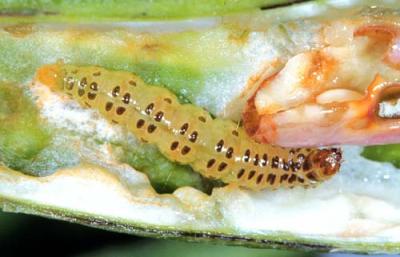

Legume pod borer (Maruca vitrata)
This is the most important pod borer pest, causing severe damage to cowpeas. Losses over 80% have been reported on indigenous varieties and even on high yielding varieties.
Moths usually lay eggs on flower buds, flowers, or on terminal shoots of young plants. Young caterpillars may feed on any part of the flowers or foliage. Several young caterpillars may be found together among flowers. Older caterpillars are highly mobile, feeding continuously on flowers and newly formed pods, causing severe damage to the crop. Upon reaching maturity the caterpillars drop from flowers or pods onto the soil and pupate beneath the plant under leaf debris.
Caterpillars of the legume pod borer are dull to yellow-white and often reach a length of 1.8 cm. Each segment has dark spots that form a distinct series along the length of the body. The head is dark brown to black.
- In Ghana, spraying with neem extracts and use of the trap crop Crotalaria juncea has been recommended (GTZ/PPRSD). Neem products showed to be effective against the legume pod borer in Niger. Weekly applications of an aqueous neem seed extract proved to be more effective than neem oil at 12l/ha (Dreyer and Ostermann, 1995).
- Leaf and bark extracts of the forest trees Khaya anthotheca and K. grandifolia proved to have the same insecticidal and anti-feedant properties like neem on the legume pod borer in West Africa (IITA).
